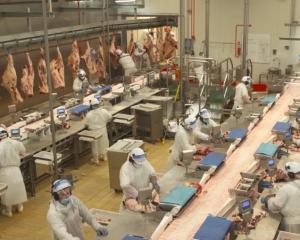The spectacular rise in dairy prices could be matched by an equally spectacular fall.
Westpac is forecasting Fonterra's final payout for this season to be $6 a kg of milk solids but returning to close to traditional levels of $5.30 a kg of milk solids for the 2009-10 season, due to the global economic crisis.
In its latest Agribiz market outlook, Westpac economist Doug Steel was more optimistic for lamb and forestry, especially logs, but did not see a recovery in beef prices from their current low levels until late next year.
Mr Steel said farmers and the export sector were benefiting from lower interest rates, which could hit 4% by mid 2009, but they were also seeing the benefits of flexible macroeconomic policies.
"While it is near impossible to estimate how the large changes in many relative prices will balance out in the bottom line for agriculture, we can be confident that if it wasn't for the flexibility of the macroeconomic framework in New Zealand allowing speedy reactions to world developments, the eventual outcome would be a lot worse."
Product prices would be lower and affect farmer incomes, but countering that was a lower exchange rate, which would remain volatile and could slip to the mid-US40c range, lower interest rates and lower fuel and fertiliser costs.
International dairy prices were expected to tumble sharply in the coming months as weaker demand met growing supplies and stocks.
"World prices are expected to be 64% below their peak levels by the end of the 2008-09 season," Mr Steel said.
The payout for 2006-07 was $4.46, rising to $7.90 for 2007-08.
While $5.30/kg of milk solids was still 40c/kg above the seven-year average, it was unknown how fast or steep the expected decline would be.
The lower incomes could surprise some new to the industry.
Mr Steel warned there was a risk his dairy predictions could be optimistic, with some in the industry forecasting a payout below $6/kg.
"There appears more down side risk than up side to these forecasts, despite the declines in the New Zealand dollar to date, and forecast further falls."
He also doubted lower beef prices would recover soon, despite meat companies predicting a recovery early in the New Year.
Mr Steel expected a recovery in late 2009, after prices slipped to their lowest level in four and a-half years, as the market absorbed a higher United States beef kill, and consumers traded down to lower-value cuts, and cheaper pork or chicken.
"We expect more down side to international beef prices in the short term on weaker demand and high inventories. This will flow through to prices at the farm gate, despite a lower New Zealand dollar," he said.
Prices for lamb were expected to average $5/kg this season, compared to $4/kg last season, falling to an average of $4.70/kg in 2009-10.
Supply of lamb was lower throughout the world, but the credit crunch could result in consumers opting for cheaper meat such as pork and chicken.
Log prices were expected to stay strong as exports benefited from the lower currency and shipping prices, which had almost halved in recent months; but the international housing downturn was affecting lumber prices, Mr Steel said.












